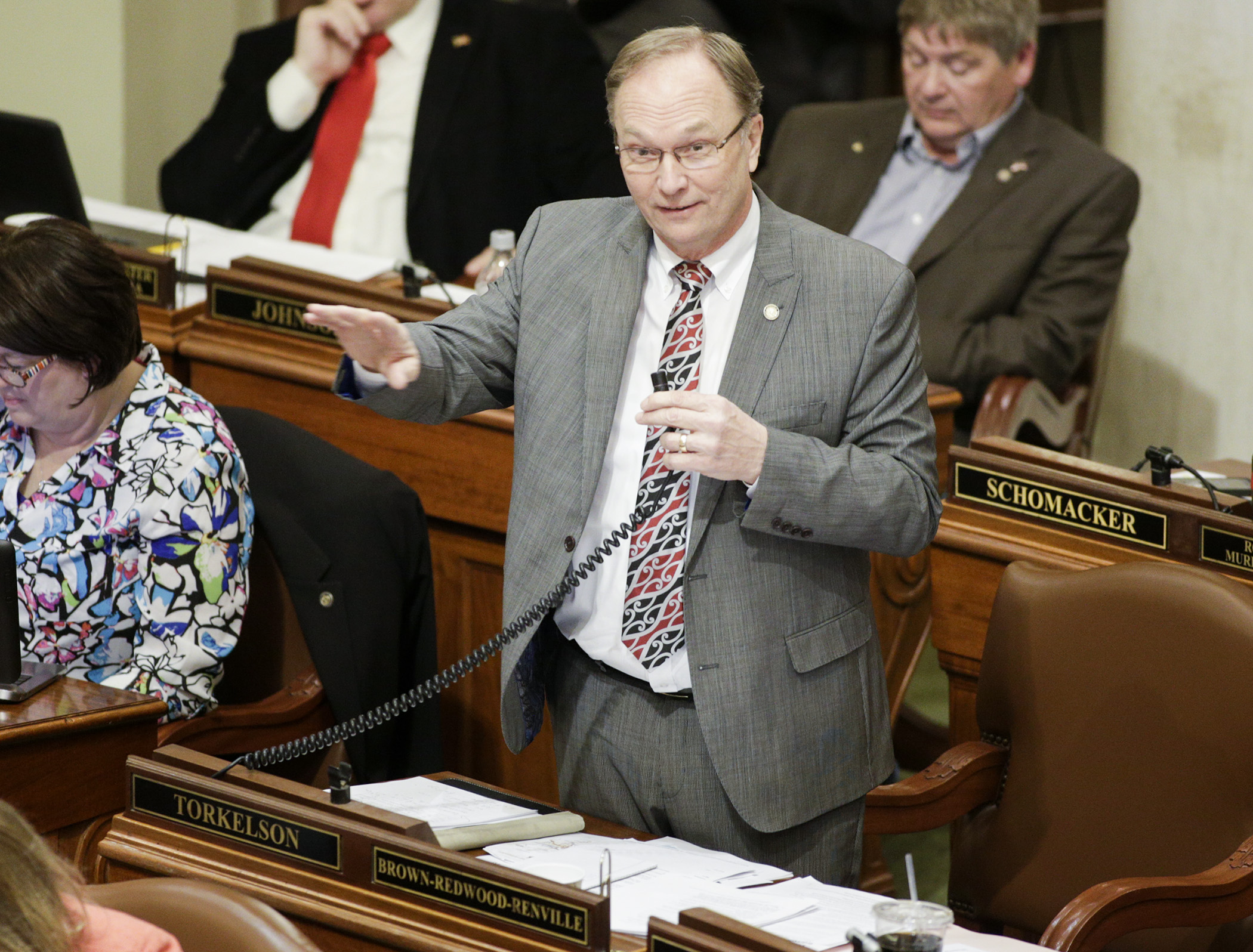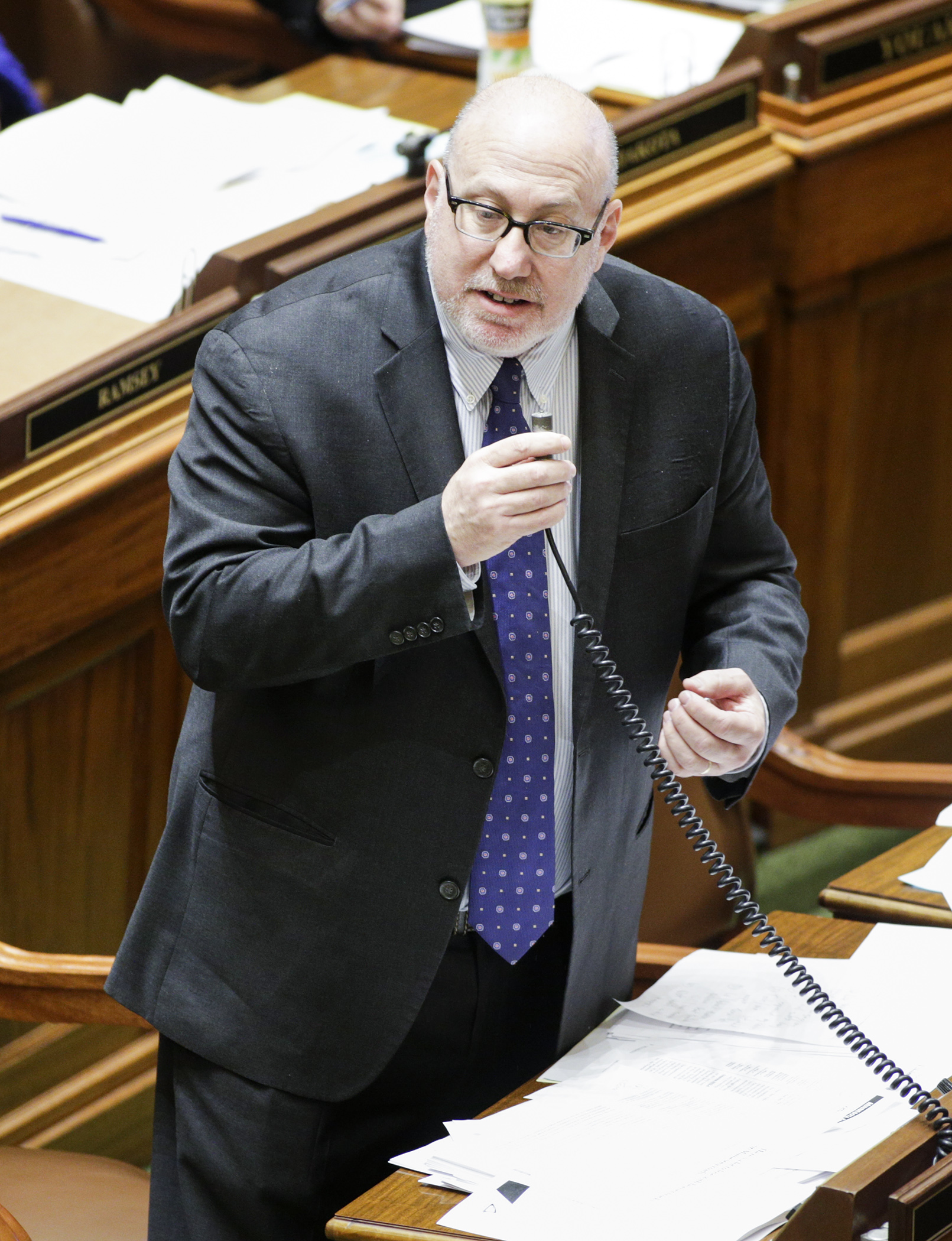Roads and bridges focus of transportation bill passed in House, but opponents say transit to suffer

The House on Friday passed an omnibus transportation finance bill that would rely heavily on borrowing and General Fund dollars to increase state spending by roughly $2 billion on roads and bridges over the next two years.
Passed, as amended, on a 76-54 vote, HF861, its Republican backers say, will give the state’s roads and bridges a badly needed infusion of construction funding and will rein in metro area plans for new rail lines. It’s part of $5.9 billion in proposed transportation appropriations in the 2018-19 budget.
Critics, however, argued the bill represents another short-term approach to transportation funding that pits roads, bridges, buses and trains against health care and schools, attacks metro area transit and borrows too heavily to meet the state’s road infrastructure needs.
The legislation would boost road and bridge funding by roughly $2 billion over the next two years, in part, by moving an estimated $450 million in transportation-related sales tax revenues that currently go into the General Fund into a new transportation fund. It would also utilize more than $1 billion in trunk highway borrowing and introduce an annual $75 fee on electric vehicles.
 Rep. Frank Hornstein speaks to his amendment during House debate on the omnibus transportation finance bill March 31. Photo by Paul Battaglia
Rep. Frank Hornstein speaks to his amendment during House debate on the omnibus transportation finance bill March 31. Photo by Paul Battaglia“We have the funds available to put together a robust transportation bill right now,” said Rep. Paul Torkelson (R-Hanska), chair of the House Transportation Finance Committee and the bill’s sponsor “And we should do it using the resources that are available.”
Torkelson praised the Republican approach of finding ways to grow transportation funding without raising the gas tax. That’s the approach that has been favored by DFLers and Gov. Mark Dayton, who have said it would create a more sustainable, long-term injection of new funding.
Measures that would redirect the already-collected, transportation-related tax revenues from the General Fund into a new transportation account were amended out of the bill in committee and passed Thursday as part of the omnibus tax bill.
In all, Republicans say the plan passed Friday would raise an additional $6 billion for roads and bridges over the next decade.
DFLers derided those funds as simply a shift in existing dollars rather than new funding for transportation.
“There is not one dollar of new, dedicated funding for transportation,” said House Minority Leader Melissa Hortman (DFL-Brooklyn Park).
HF861 now goes to the Senate. There, Sen. Scott Newman (R-Hutchinson), sponsors an omnibus transportation finance bill, SF1060, that was passed 38-28 Thursday and then tabled.
Impacts on transit
DFLers saved some of their harshest criticism for measures that would cut $53 million in base funding to the Metropolitan Council for transit service, and would end longstanding state assistance for transit operations and maintenance.
Metro Transit officials have said those funding reductions would mean deep cuts — in the neighborhood of 40 percent — to regular route bus service that is the backbone of the transit system.
House Majority Leader Joyce Peppin (R-Rogers) said the DFL has “prioritized trains” during transportation talks in recent years, and Torkelson said he believes those estimates to be exaggerated.
WATCH Omnibus transportation finance is introduced on the House Floor
But a number of DFL members disagreed, characterizing the bill as an attack on urban transit that would harm the Twin Cities metropolitan area and the state as a whole.
“I’ve seen a lot of bad transportation bills in my day that cut deeply into transit,” Rep. Frank Hornstein (DFL-Mpls) said during a morning news conference. “But, nothing like this.”
Transit policy measures
HF861 also includes a number of policy provisions that take direct aim at Metropolitan Transit operations, and current and future metro area light-rail transit projects.
Proposed transit and regional governance policy measures in the bill include:
- a directive to the Metropolitan Council to set an objective of 40 percent farebox recovery — the amount of operating costs recovered by paid fares — by 2022;
- requiring legislative approval before a regional rail authority, county or city in the Twin Cities metropolitan area, or the Metropolitan Council, can spend funds on the study, project development or construction related to any light-rail transit project; and
- prohibiting the Metropolitan Council from using certificates of participation or other debt obligations that are backed by motor vehicle sales tax revenues. The Metropolitan Council, Counties Transit Improvement Board and Hennepin County Regional Rail Authority used a similar financing maneuver after state funding for the Southwest LRT project fell through.
What else is in the bill?
- Appropriations for non-highway transportation modes including aeronautics, transportation and freight rail that include increased funds for airport development, $5 million in funding for the Minnesota Rail Service Improvement program and $9 million for freight rail safety projects;
- reformulated allocation of a portion of revenue from motor vehicle lease taxes;
- Minnesota State Patrol funding for patrolling highways, commercial vehicle enforcement and State Capitol security;
- $1.5 million, one-time allocation to the Metropolitan Council in Fiscal Year 2018 to fund a suburb-to-suburb transit pilot program; and
- elimination of MnDOT’s Passenger Rail Office.
Other policy measures
The bill also includes a number of other policy proposals, including some that would:
- direct MnDOT to establish a process outside of administrative rulemaking to handle appeals of driveway access permit denial or revocation for owners of land that abuts a trunk highway;
- prevent MnDOT from requiring that projects proposed for the Corridors of Commerce program be ready for construction in under three years;
- create liability limits on potential freight rail accidents in circumstances involving co-location with light rail transit;
- designate a stretch of Highway 65 near Cambridge as the “Chip A. Imker Memorial Highway;”
- designate a portion Highway 23 in the city of Paynesville as the “Medal of Honor recipient Kenneth L. Olson Highway;”
- designate a Highway 52 bridge in Coates as the “Corporal Benjamin S. Kopp Bridge;”
- require MnDOT to track local government spending for trunk highway system work;
- require MnDOT to find 15 percent savings through efficiencies;
- alter MnDOT’s Corridors of Commerce project selection process to give preference to Greater Minnesota projects that have been previously funded and metro area projects that would provide additional capacity on non-interstate highways with annual daily traffic volume of at least 50,000 vehicles;
- amendments to the state’s outdoor sign regulations governing roadside advertising; and
- grant a weight limit waiver to milk trucks on state highways.
Amendments
Amendments adopted on the House Floor include:
- granting the city of New Brighton the authority to open a full-service driver’s license office in its city hall;
- adoption of 2015 national school bus design standards in Minnesota; and
- changes to rules around how school buses may stop in right-turn lanes.
Related Articles
Search Session Daily
Advanced Search OptionsPriority Dailies
Ways and Means Committee OKs proposed $512 million supplemental budget on party-line vote
By Mike Cook Meeting more needs or fiscal irresponsibility is one way to sum up the differences among the two parties on a supplemental spending package a year after a $72 billion state budg...
Meeting more needs or fiscal irresponsibility is one way to sum up the differences among the two parties on a supplemental spending package a year after a $72 billion state budg...
Minnesota’s projected budget surplus balloons to $3.7 billion, but fiscal pressure still looms
By Rob Hubbard Just as Minnesota has experienced a warmer winter than usual, so has the state’s budget outlook warmed over the past few months.
On Thursday, Minnesota Management and Budget...
Just as Minnesota has experienced a warmer winter than usual, so has the state’s budget outlook warmed over the past few months.
On Thursday, Minnesota Management and Budget...